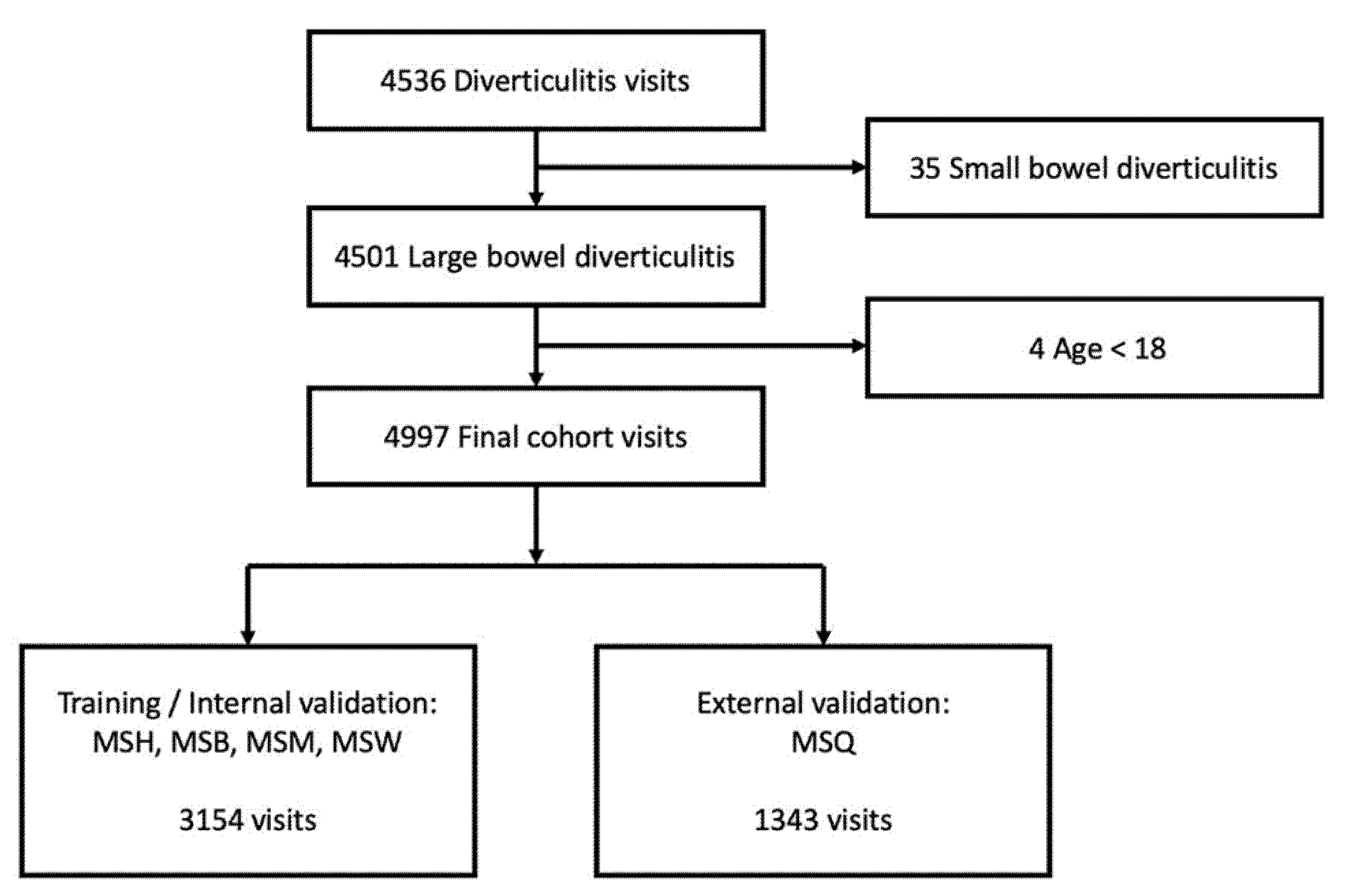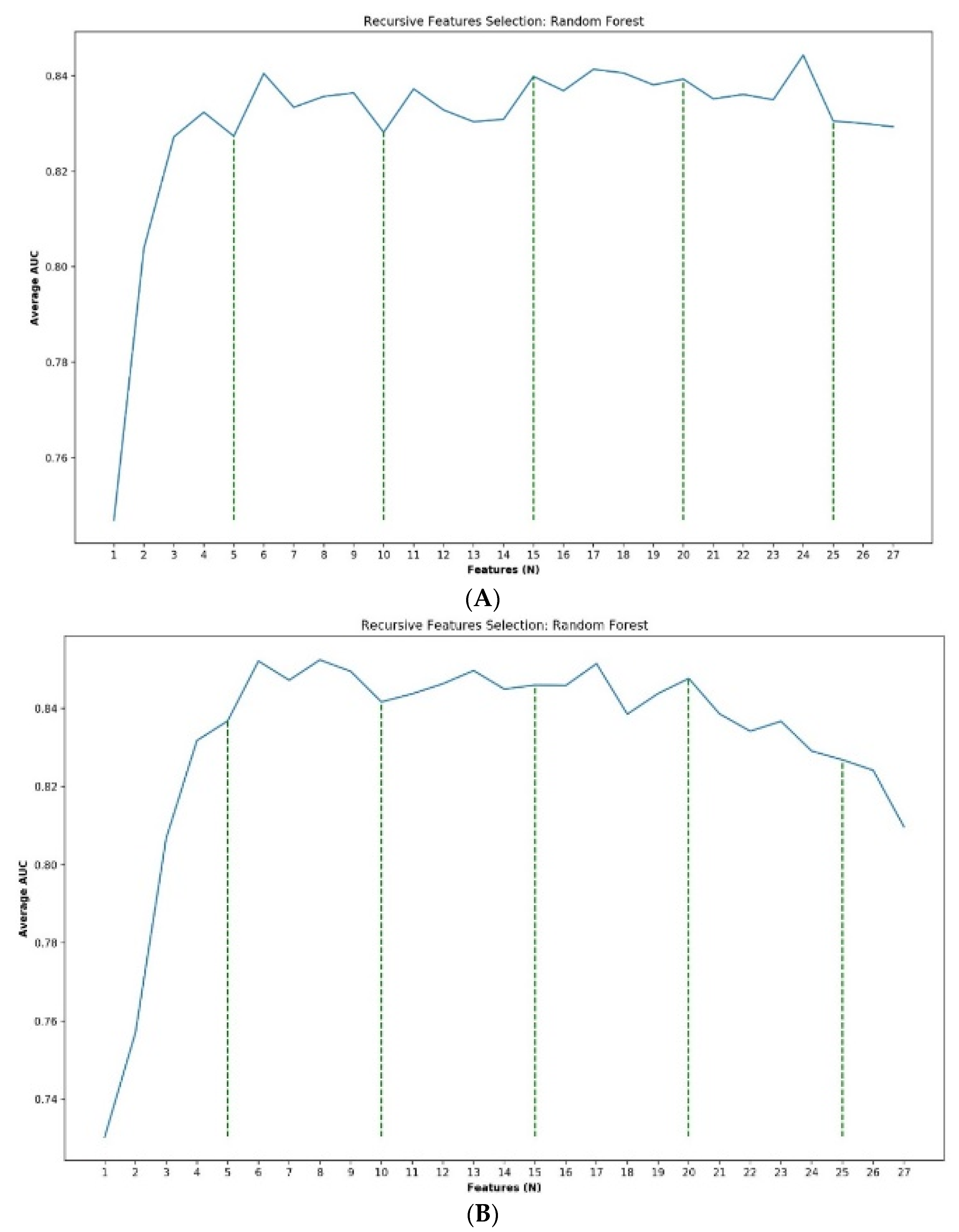Machine Learning Model for Outcome Prediction of Patients Suffering from Acute Diverticulitis Arriving at the Emergency Department—A Proof of Concept Study
Abstract
:1. Introduction
2. Materials and Methods
2.1. Study Design
2.2. Inclusion and Exclusion Criteria
2.3. Machine Learning Models
2.4. Statistical Analysis
3. Results
Machine Learning Models
4. Discussion
Author Contributions
Funding
Institutional Review Board Statement
Informed Consent Statement
Conflicts of Interest
References
- Hughes, L.E. Postmortem survey of diverticular disease of the colon. Gut 1969, 10, 336–351. [Google Scholar] [CrossRef] [Green Version]
- Garcia, G. Diverticulitis. In Infecttions of the Gastrointestinal Tract, 2nd ed.; Blaser, M.T., Smith, D.D., Ravdin, J.I., Greenberg, H.B., Guerrant, R.L., Eds.; Lippincott Williams & Wilkins: Philadelphia, PA, USA, 2002; pp. 306–316. [Google Scholar]
- Parks, T.G. Natural History of Diverticular Disease of the Colon. Clin. Gastroenterol. 1975, 4, 53–69. [Google Scholar] [CrossRef]
- Painter, N.S.; Burkitt, D.P. Diverticular disease of the colon, a 20th cencury problem. Clin. Gastroenterol. 1975, 4, 3–21. [Google Scholar] [CrossRef]
- Farrell, R.J.; Farrell, J.J.; Morrin, M.M. Diverticular disease in the elderly. Gastroenterol. Clic. 2001, 30, 475–496. [Google Scholar] [CrossRef]
- Wong, W.D.; Wexner, S.D.; Lowry, A.; Vernava, A., III; Burnstein, M.; Denstman, F.; Fazio, V.; Kerner, B.; Moore, R.; Oliver, G.; et al. Pratice parameters for the treatment of sigmoid diverticulitis-supporting documentation. Dis. Colon. Rectum 2000, 43, 289–297. [Google Scholar] [CrossRef] [PubMed]
- Shahedi, K.; Fuller, G.; Bolus, R.; Cohen, E.; Vu, M.; Shah, R.; Agarwal, N.; Kaneshiro, M.; Atia, M.; Sheen, V.; et al. Long-term Risk of Acute Diverticulitis Among Patients With Incidental Diverticulosis Found During Colonoscopy. Clin. Gastroenterol. Hepatol. 2013, 11, 1609–1613. [Google Scholar] [CrossRef] [Green Version]
- Peery, A.F.; Crockett, S.D.; Murphy, C.C.; Lund, J.L.; Dellon, E.S.; Williams, J.L.; Jensen, E.T.; Shaheen, N.J.; Barritt, A.S.; Lieber, S.R.; et al. Burden and Cost of Gastrointestinal, Liver, and Pancreatic Diseases in the United States: Update 2018. Gastroenterology 2019, 156, 254–272. [Google Scholar] [CrossRef] [PubMed] [Green Version]
- Binda, G.A.; Mataloni, F.; Bruzzone, M.; Carabotti, M.; Cirocchi, R.; Nascimbeni, R.; Gambassi, G.; Amato, A.; Vettoretto, N.; Pinnarelli, L.; et al. Trends in hospital admission for acute diverticulitis in Italy from 2008 to 2015. Tech. Coloproctol. 2018, 22, 597–604. [Google Scholar] [CrossRef]
- Jeyarajah, S.; Faiz, O.; Bottle, A.; Aylin, P.; Bjarnason, I.; Tekkis, P.P.; Papagrigoriadis, S. Diverticular disease hospital admissions are increasing, with poor outcomes in the elderly and emergency admissions. Aliments Pharmacol. Ther. 2009, 30, 1171–1182. [Google Scholar] [CrossRef] [PubMed]
- Bharucha, A.E.; Parthasarathy, G.; Ditah, I.; Fletcher, J.G.; Ewelukwa, O.; Pendlimari, R.; Yawn, B.P.; Melton, J.L.; Schleck, C.; Zinsmeister, A.R. Temporal Trends in the Incidence and Natural History of Diverticulitis: A Population-Based Study. Am. J. Gastroenterol. 2015, 110, 1589–1596. [Google Scholar] [CrossRef] [PubMed] [Green Version]
- Humes, D.J.; Solaymani–Dodaran, M.; Fleming, K.M.; Simpson, J.; Spiller, R.; West, J. A Population-Based Study of Perforated Diverticular Disease Incidence and Associated Mortality. Gastroenterology 2009, 136, 1198–1205. [Google Scholar] [CrossRef] [PubMed]
- Bolkenstein, H.E.; Van De Wall, B.J.M.; Consten, E.C.J.; Broeders, I.; Draaisma, W.A. Risk factors for complicated diverticulitis: Systematic review and meta-analysis. Int. J. Color. Dis. 2017, 32, 1375–1383. [Google Scholar] [CrossRef] [PubMed] [Green Version]
- Slim, K.; Joris, J.; Beyer-Berjot, L. The end of antibiotics in the management of uncomplicated acute diverticulitis. J. Visc. Surg. 2019, 156, 373–375. [Google Scholar] [CrossRef]
- Strate, L.L.; Morris, A.M. Epidemiology, Pathophysiology, and Treatment of Diverticulitis. Gastroenterology 2019, 156, 1282–1298.e1. [Google Scholar] [CrossRef] [PubMed] [Green Version]
- Mäkelä, J.T.; Klintrup, K.; Takala, H.; Rautio, T. The role of C-reactive protein in prediction of the severity of acute diverticulitis in an emergency unit. Scand. J. Gastroenterol. 2015, 50, 536–541. [Google Scholar] [CrossRef]
- Nizri, E.; Spring, S.; Ben-Yehuda, A.; Khatib, M.; Klausner, J.; Greenberg, R. C-reactive protein as a marker of complicated diverticulitis in patients on anti-inflammatory medications. Tech. Coloproctol. 2014, 18, 145–149. [Google Scholar] [CrossRef]
- Pisanu, A.; Vacca, V.; Reccia, I.; Podda, M.; Uccheddu, A. Acute Diverticulitis in the Young: The Same Disease in a Different Patient. Gastroenterol. Res. Pr. 2013, 2013, 867961. [Google Scholar] [CrossRef]
- Tursi, A.; Brandimarte, G.; Giorgetti, G.; Elisei, W.; Maiorano, M.; Aiello, F. The Clinical Picture of Uncomplicated Versus Complicated Diverticulitis of the Colon. Dig. Dis. Sci. 2008, 53, 2474–2479. [Google Scholar] [CrossRef]
- van de Wall, B.J.M.; Draaisma, W.A.; van der Kaaij, R.T.; Consten, E.C.J.; Wiezer, M.J.; Broeders, I.A.M.J. The value of inflammation markers and body temperature in acute diverticulitis. Color. Dis. 2013, 15, 621–626. [Google Scholar] [CrossRef]
- Tan, J.P.; Barazanchi, A.W.; Singh, P.P.; Hill, A.G.; Maccormick, A.D. Predictors of acute diverticulitis severity: A systematic review. Int. J. Surg. 2016, 26, 43–52. [Google Scholar] [CrossRef]
- Longstreth, G.F.; Iyer, R.L.; Chu, L.-H.X.; Chen, W.; Yen, L.S.; Hodgkins, P.; Kawatkar, A.A. Acute diverticulitis: Demographic, clinical and laboratory features associated with computed tomography findings in 741 patients. Aliment. Pharmacol. Ther. 2012, 36, 886–894. [Google Scholar] [CrossRef] [PubMed]
- Cologne, K.G.; Skiada, D.; Beale, E.; Inaba, K.; Senagore, A.J.; Demetriades, D. Effects of diabetes mellitus in patients presenting with diverticulitis. J. Trauma Acute Care Surg. 2014, 76, 704–709. [Google Scholar] [CrossRef]
- Barash, Y.; Soffer, S.; Grossman, E.; Tau, N.; Sorin, V.; Bendavid, E.; Irony, A.; Konen, E.; Zimlichman, E.; Klang, E. Alerting on mortality among patients discharged from the emergency department: A machine learning model. Postgrad. Med. J. 2020. [Google Scholar] [CrossRef]
- Soffer, S.; Klang, E.; Barash, Y.; Grossman, E.; Zimlichman, E. Predicting In-Hospital Mortality at Admission to the Medical Ward: A Big-Data Machine Learning Model. Am. J. Med. 2021, 134, 227–234.e4. [Google Scholar] [CrossRef]
- Bolkenstein, H.E.; Van De Wall, B.J.; Consten, E.C.; van der Palen, J.; Broeders, I.A.; Draaisma, W.A. Development and validation of a diagnostic prediction model distinguishing complicated from uncomplicated diverticulitis. Scand. J. Gastroenterol. 2018, 53, 1291–1297. [Google Scholar] [CrossRef] [PubMed]
- Hinchey, E.J.; Schaal, P.G.; Richards, G.K. Treatment of perforated diverticular disease of the colon. Adv. Surg. 1978, 12, 85–109. [Google Scholar]
- Dharmarajan, S.; Hunt, S.R.; Birnbaum, E.H.; Fleshman, J.W.; Mutch, M.G. The efficacy of non-operative management of acute complicated diverticulitis. Dis. Colon. Rectum 2011, 54, 663–671. [Google Scholar] [CrossRef]
- Covino, M.; Papa, V.; Tursi, A.; Simeoni, B.; Lopetuso, L.; Vetrone, L.; Franceschi, F.; Rapaccini, G.; Gasbarrini, A.; Papa, A. Development and Validation of Predictive Assessment of Complicated Diverticulitis Score. J. Pers. Med. 2021, 11, 80. [Google Scholar] [CrossRef] [PubMed]



| Uncomplicated AD (n = 4368, 97.1%) | Complicated AD (n = 129, 2.9%) | p Value | |
|---|---|---|---|
| Demographics | |||
| Age, median (IQR), y | 58.0 (48.0–69.0) | 56.0 (48.0–67.0) | 0.348 |
| Female, N. (%) | 2561 (58.6) | 57 (44.2) | 0.001 |
| Black, N. (%) | 750 (17.2) | 34 (26.4) | 0.010 |
| White, N. (%) | 1390 (31.8) | 45 (34.9) | 0.523 |
| ED Triage | |||
| Arrival Mode: EMS, N. (%) | 466 (10.7) | 25 (19.4) | 0.003 |
| Arrival Mode: BLS, N. (%) | 254 (5.8) | 19 (14.7) | <0.001 |
| ESI, median (IQR), Acuity level (1–5) | 3.0 (3.0–3.0) | 3.0 (3.0–3.0) | <0.001 |
| Vital Signs | |||
| SBP, median (IQR), mmHg | 135.0 (122.0–150.0) | 132.0 (117.0–148.0) | 0.171 |
| DBP, median (IQR), mmHg | 78.0 (70.0–86.0) | 77.0 (66.0–88.0) | 0.511 |
| Heart rate, median (IQR), b/min | 87.0 (76.0–98.0) | 98.0 (86.0–110.0) | <0.001 |
| Temperature, median (IQR), Celsius | 36.7 (36.4–37.1) | 36.8 (36.5–37.2) | 0.026 |
| Respirations, median (IQR), num/min | 18.0 (18.0–19.0) | 18.0 (18.0–19.0) | 0.295 |
| O2 saturation, median (IQR)% | 98.0 (97.0–99.0) | 98.0 (97.0–99.0) | 0.042 |
| Pain scale, median (IQR), (0–10) | 7.0 (5.0–9.0) | 7.0 (5.0–10.0) | 0.652 |
| Comorbidities | |||
| CAD, N. (%) | 452 (10.3) | 11 (8.5) | 0.600 |
| CHF, N. (%) | 262 (6.0) | 13 (10.1) | 0.086 |
| DM, N. (%) | 933 (21.4) | 27 (20.9) | 0.993 |
| HTN, N. (%) | 1443 (33.0) | 46 (35.7) | 0.597 |
| CKD, N. (%) | 270 (6.2) | 6 (4.7) | 0.598 |
| COPD, N. (%) | 305 (7.0) | 10 (7.8) | 0.871 |
| NEOPLASTIC, N. (%) | 873 (20.0) | 21 (16.3) | 0.353 |
| Past or present smoking, N. (%) | 1455 (33.3) | 47 (36.4) | 0.518 |
| BMI, median (IQR), kg/m2 | 28.3 (24.9–32.7) | 28.7 (25.1–34.0) | 0.455 |
| Laboratory values | |||
| WBC, median (IQR), x103/uL | 10.5 (8.1–13.2) | 13.9 (11.1–17.7) | <0.001 |
| NEUT, median (IQR), ×103/uL | 7.6 (5.4–10.1) | 11.6 (8.5–15.1) | <0.001 |
| HGB, median (IQR), g/dL | 13.5 (12.4–14.5) | 13.0 (11.9–14.4) | 0.005 |
| PLT, median (IQR), g/dL | 243.0 (202.0–292.0) | 300.0 (234.0–382.0) | <0.001 |
| Albumin, median (IQR), g/dL | 3.9 (3.6–4.1) | 3.6 (3.1–3.9) | <0.001 |
| Lactate, median (IQR), mg/dL | 1.2 (0.9–1.6) | 1.3 (1.1–2.1) | 0.001 |
| BUN, median (IQR), mg/dL | 13.0 (10.0–17.0) | 13.0 (10.0–18.0) | 0.022 |
| Cr, median (IQR), mg/dL | 0.8 (0.7–1.0) | 0.9 (0.7–1.2) | 0.112 |
| Na, median (IQR), mEq/L | 139.0 (137.0–140.0) | 137.0 (135.0–140.0) | <0.001 |
| K, median (IQR), mEq/L | 4.1 (3.8–4.4) | 4.1 (3.7–4.4) | 0.373 |
| Cl, median (IQR), mEq/L | 104.0 (102.0–106.0) | 102.0 (100.0–104.0) | <0.001 |
| Laboratory Variable | AUC | Youden’s Index |
|---|---|---|
| NEUT | 0.73 (95% CI: 0.68–0.78) | 10.5 × 103/μL |
| WBC | 0.70 (95% CI: 0.65–0.76) | 12.3 × 103/μL |
| Albumin | 0.69 (95% CI: 0.63–0.74) | 3.4 g/dL |
| PLT | 0.68 (95% CI: 0.62–0.73) | 312.0 × 103/μL |
| Cl | 0.64 (95% CI: 0.59–0.69) | 103.0 mEq/L |
| Lactate | 0.61 (95% CI: 0.56–0.67) | 0.9 mg/dL |
| Na | 0.61 (95% CI: 0.56–0.66) | 138.0 mEq/L |
| HGB | 0.56 (95% CI: 0.50–0.61) | 12.6 g/dL |
| Fixed Specificity | Sensitivity | Specificity | FPR | PPV | NPV | F1 |
|---|---|---|---|---|---|---|
| Youden’s index | 0.88 (95% CI: 0.71–1.00) | 0.72 (95% CI: 0.70–0.75) | 1:3.6 | 0.05 (95% CI: 0.03–0.08) | 0.99 (95% CI: 0.99–1.00) | 0.10 (95% CI: 0.06–0.14) |
| 90% | 0.50 (95% CI: 0.30–0.70) | 0.90 | 1:10 | 0.08 (95% CI: 0.04–0.13) | 0.99 (95% CI: 0.98–1.00) | 0.14 (95% CI: 0.07–0.22) |
| 95% | 0.38 (95% CI: 0.18–0.57) | 0.95 | 1:20 | 0.12 (95% CI: 0.05–0.20) | 0.99 (95% CI: 0.98–0.99) | 0.18 (95% CI: 0.08–0.28) |
| 99% | 0.04 (95% CI: 0.00–0.14) | 0.99 | 1:100 | 0.08 (95% CI: 0.00–0.25) | 0.98 (95% CI: 0.98–0.99) | 0.05 (95% CI: 0.00–0.16) |
Publisher’s Note: MDPI stays neutral with regard to jurisdictional claims in published maps and institutional affiliations. |
© 2021 by the authors. Licensee MDPI, Basel, Switzerland. This article is an open access article distributed under the terms and conditions of the Creative Commons Attribution (CC BY) license (https://creativecommons.org/licenses/by/4.0/).
Share and Cite
Klang, E.; Freeman, R.; Levin, M.A.; Soffer, S.; Barash, Y.; Lahat, A. Machine Learning Model for Outcome Prediction of Patients Suffering from Acute Diverticulitis Arriving at the Emergency Department—A Proof of Concept Study. Diagnostics 2021, 11, 2102. https://doi.org/10.3390/diagnostics11112102
Klang E, Freeman R, Levin MA, Soffer S, Barash Y, Lahat A. Machine Learning Model for Outcome Prediction of Patients Suffering from Acute Diverticulitis Arriving at the Emergency Department—A Proof of Concept Study. Diagnostics. 2021; 11(11):2102. https://doi.org/10.3390/diagnostics11112102
Chicago/Turabian StyleKlang, Eyal, Robert Freeman, Matthew A. Levin, Shelly Soffer, Yiftach Barash, and Adi Lahat. 2021. "Machine Learning Model for Outcome Prediction of Patients Suffering from Acute Diverticulitis Arriving at the Emergency Department—A Proof of Concept Study" Diagnostics 11, no. 11: 2102. https://doi.org/10.3390/diagnostics11112102
APA StyleKlang, E., Freeman, R., Levin, M. A., Soffer, S., Barash, Y., & Lahat, A. (2021). Machine Learning Model for Outcome Prediction of Patients Suffering from Acute Diverticulitis Arriving at the Emergency Department—A Proof of Concept Study. Diagnostics, 11(11), 2102. https://doi.org/10.3390/diagnostics11112102







